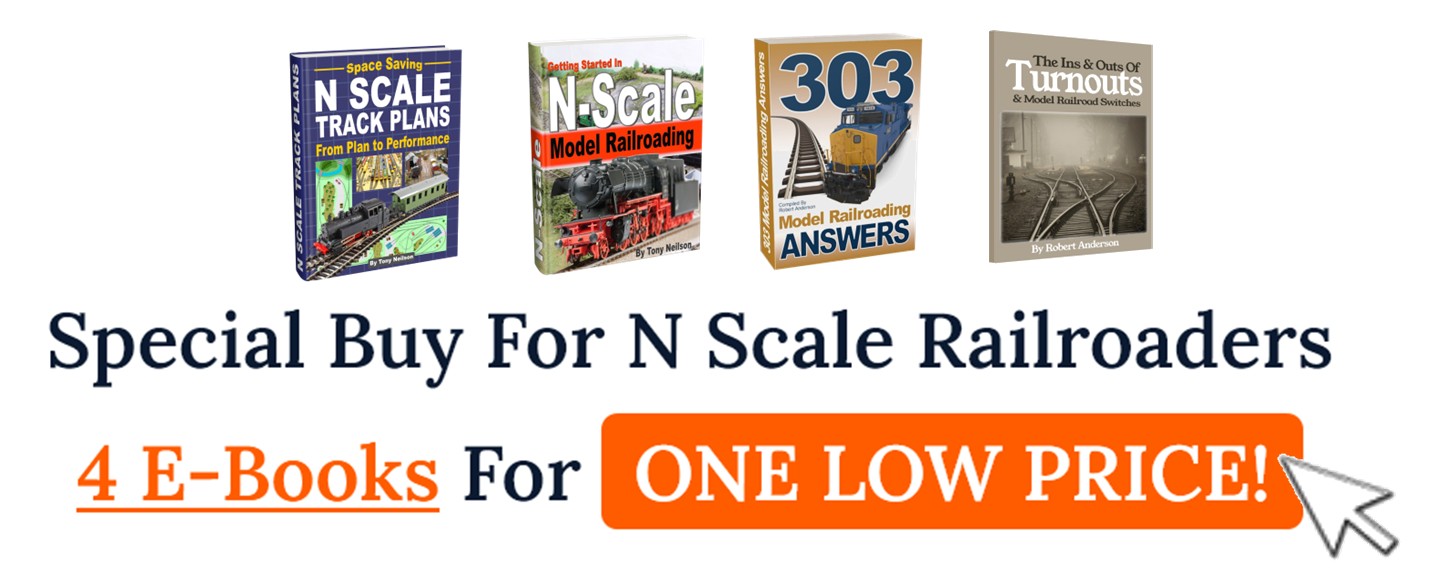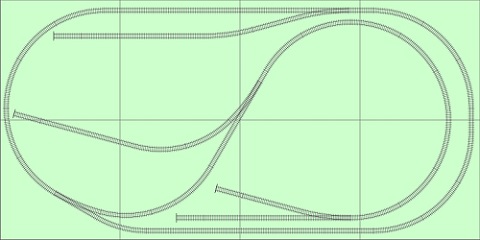Make Your Layout More Interesting
By Researching N Gauge Track Plans

The Small Oval N Gauge Track Plan for Beginners
An oval n gauge layout plan is one of the most basic and simple track plans to begin with. It takes minimum space in your railroad and is easier to start with. It can be as little as 46 inches x 25 inches, which makes it manageable. If you are only just starting the hobby then this is a great track to start with and can potentially be expanded as you progress. There are certain modifications that you can add in your trackage to make it more interesting like adding sidings that run along the main train track or in the center. You can also improve the effects in your setup by simply designing a backdrop for your model railroad.
Double Oval N Gauge Layout Plans
Adding another oval in your simple oval N model railroad track plan will make your layout a bit more interesting. It could be 70 inches x 28 inches with four turnouts that allow your train to move in two ovals.
Using two ovals in your track plan will allow you to add two trains in your railway that may move in different directions. Here you have the option of dividing the track electrically which will allow you to control both the trains separately.
N Gauge Plans With Sidings
Another track design option would be a layout with three siding and two turn points. The longest siding on the track could hold 5 wagons, whereas the other two sidings could accommodate 3 wagons each.
One thing that you should keep in mind while using a layout plan like this, is that the longest siding should be long enough to support the longest locomotive in your railroad. You could also add curves and then make the required changes to the track plan to add buildings, sceneries and other accessories in your setup.
Runaround Loop for an N Gauge Layout
Adding a runaround loop in your model railway will make it more interesting. However, adding a loop in your track will pose some wiring challenges. To park a locomotive in the extended loop you will have to wire it separately, which can be a bit challenging if you are not using digital command and control. Needless to say that the loop should fit your layout and should also be long enough to accommodate the locomotive that you are using in your model railway. Curves should not be too tight otherwise you could experience a lot of derailments.
There are other N gauge plans that you can add in your model train layout to make it more interesting and challenging. As you work with different tracks and gain more experience, working with different track configurations will not only become easier but it will also become more enjoyable. To make your railway setup more interesting you can add accessories and backdrop to add a touch of realism in your model.
Is an N Gauge Railway Right for You?
Making the decision of which scale to model can be daunting. A simple loop of track in any scale would fit in most homes, but the attraction of having a train run around a simple loop fades quickly. Plans to expand the layout begin to form as soon as the modeling bug bites, which leads to the first conflict – where is this layout likely to be built? A roomy basement is the ideal location, but often the budding railroader will have to consider portability or restricted space. This is when the scale question becomes critical. Choosing a scale to model is a commitment well worth considering at length before the sawdust starts to fly.
HO-scale is the most popular modeling scale in the world today. There are literally thousands of products available in that scale, and the equipment and structures are convenient to work with for people with average skills. Putting derailed rolling stock back on the track is relatively easy, and the entry level cost is reasonable. HO-scale popularity notwithstanding, N-scale offers some distinct advantages. At half the size of HO-scale, the biggest draw for the modeler is the sheer amount of railroading that can be done in a relatively small space.
N-scale products began appearing in about 1962. The first locomotives were quite crude and ran poorly. As with most products, either consumer demand drives improvements or consumer apathy eliminates the product from the market. Fortunately, demand has driven huge improvements. It is now possible to buy N-scale products that are every bit as detailed and well-running as any other scale model. Kato, Athearn, and Micro-Trains manufacture beautifully detailed and superbly running locomotives and rolling stock.
For those so inclined, super-detailing parts are also available. A good magnifying headband, strong lighting, and a good set of small tools are necessary if a lot of N-scale detailing of rail equipment or structures is to be done. Working on N gauge track plans details is more challenging than a larger scale, but not difficult to master with the proper tools. Surprisingly detailed layouts have been created in about the space of a home coffee table.
As far as products are concerned, N-Gauge has a slightly smaller selection than HO. Some esoteric rolling stock only appears rarely, or is in limited production, but keeping an eye on places like eBay can often produce opportunities to acquire items that are rare and/or out of production. The pricing of N-scale equipment is about the same as HO-scale, so there’s no economy of miniaturization. N scale has benefited from the demand of being the second most popular modeling scale, but with demand goes price!
Read the two N gauge books featured above for some really helpful tips and ideas. One of the downloadable books covers getting started, scenery, structures etc., and the other one features a wide range of N gauge model railway track plans with parts lists.
